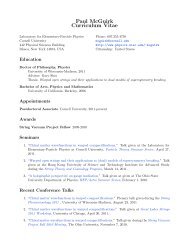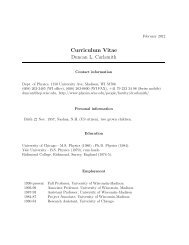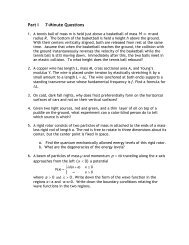The Symmetric Linear Potential [ ]
The Symmetric Linear Potential [ ]
The Symmetric Linear Potential [ ]
Create successful ePaper yourself
Turn your PDF publications into a flip-book with our unique Google optimized e-Paper software.
<strong>The</strong> <strong>Symmetric</strong> <strong>Linear</strong> <strong>Potential</strong><br />
<strong>The</strong> goal is to find analytical solutions to the TISE eigensystem for a potential of<br />
the form<br />
V ( x)<br />
<br />
<br />
b x x ,<br />
<br />
(1)<br />
where b is a constant specific to the potential in question. <strong>The</strong> first thing to notice is that<br />
the potential is symmetric, which in this case means we can classify solutions in terms of<br />
parity. For x 0 , the TISE is<br />
2 2<br />
d ψ( x)<br />
bx ( x) E ( x)<br />
2<br />
2m<br />
dx<br />
ψ ψ (2)<br />
We change variables with the definitions 1<br />
x as<br />
2<br />
<br />
a <br />
mb <br />
1/3<br />
W<br />
2<br />
<br />
<br />
ma<br />
2<br />
E<br />
( s ) (3)<br />
W<br />
and obtain a differential equation whose solutions are, in general, a linear combination of<br />
3<br />
3<br />
the Airy functions Ai ( 2 ) and Bi ( 2 ) .<br />
ψ''( ) 2 ψ ( )<br />
<br />
ψ ( ) C Ai( 2 ) C Bi( 2 )<br />
(4)<br />
3 3<br />
1 2<br />
However, Bi(ξ) diverges as . This violates the requirement that ψ 0 as<br />
, which does not make physical sense. We therefore restrict the solutions to the<br />
form<br />
ψ (5)<br />
3<br />
n<br />
( ) Cn Ai( 2 n)<br />
where C n are normalization factors. Again, this is for s 0 .<br />
At this point we consider the parity of our solutions. Even and odd eigenstates for<br />
s 0 can be extended to give the solutions for s 0 by<br />
even<br />
even<br />
odd<br />
odd<br />
ψ ( s) ψ ( s)<br />
ψ ( s) ψ ( s)<br />
(6)<br />
1 Another option is to take a <br />
2mb<br />
2 1/3<br />
and<br />
2 2<br />
W 2ma<br />
the Airy equation, but includes a factor of 2 -1/3 in the energy (9).<br />
. This leads to a more common form of
With these properties, it then stands to reason that we need the boundary conditions<br />
ψ<br />
odd<br />
3<br />
k<br />
(0) Ai( 2 <br />
k<br />
) 0<br />
dψ<br />
ds<br />
even<br />
k<br />
3<br />
(0) Ai '( 2 <br />
k<br />
) 0<br />
(7)<br />
for our (non-normalized) solutions. Normalization is done numerically as<br />
1/2<br />
<br />
1/3 2<br />
C 2 Ai( ) d<br />
<br />
n 3<br />
<br />
(8)<br />
2<br />
n n<br />
n <br />
<strong>The</strong> two equations in (7) then give the eigenvalues for odd and even parity states,<br />
respectively. Finally, we come to the conclusion that the bound state energies are given<br />
by<br />
E<br />
2 2<br />
1/3<br />
b<br />
n<br />
<br />
nW<br />
<br />
n<br />
<br />
m <br />
(9)<br />
Fig 1: An example of the symmetric linear potential theoretical eigenfunctions (n = 20). Note that since<br />
ψ is an odd state, ψ 20 (0) 0 . Observe also the decaying behavior of the wavefunction around the<br />
20<br />
classical turning points s <br />
20<br />
.


![The Symmetric Linear Potential [ ]](https://img.yumpu.com/25329322/1/500x640/the-symmetric-linear-potential-.jpg)













